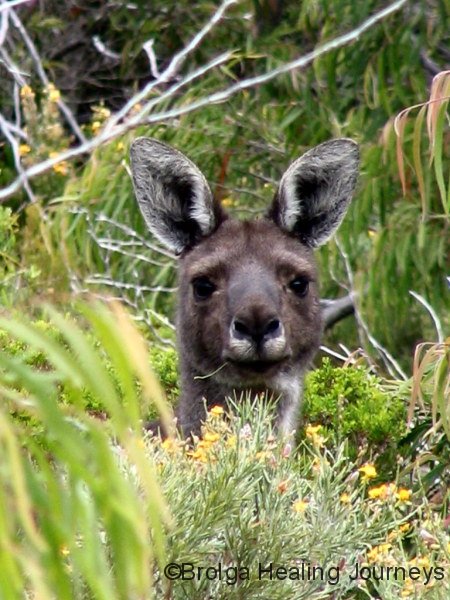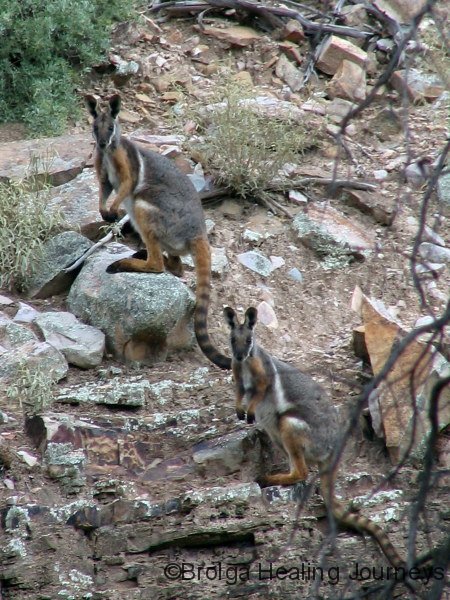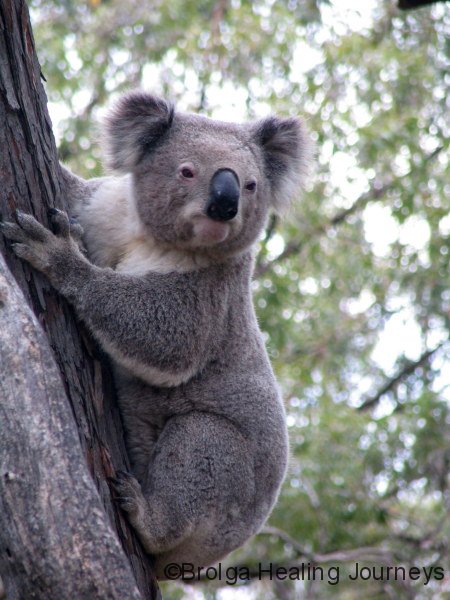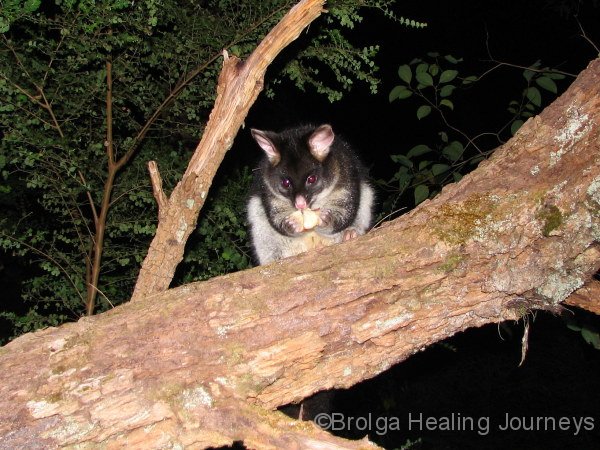Australian Marsupials

Australia is home to more than 100 species of marsupial. Some, such as the Kangaroo, are extremely well known, indeed even synonymous with Australia. Others, such as the small, carnivorous Dunnarts and Kultarrs, are virtually unknown. Modern Australia holds the unfortunate world record for mammal extinctions, with many small marsupials having disappeared since the arrival of White Man and his feral pests such as cats and foxes. Nowadays, remnant colonies of other, endangered marsupials, such as the Rufous Hare Wallaby and the Greater Billby, thrive either only on isolated islands where there are no feral predators, or in specially constructed, feral proof breeding enclosures. These ‘island’ sanctuaries give their species some hope of survival.
Marsupials are a sub-class of mammals, and have in common the pouch in which their young develop and shelter until they become independent. Most marsupials have forward-facing pouches, such as the Kangaroo, although nature has demonstrated her ingenuity by evolving backward-facing pouches in burrowing marsupials such as the Wombat and the Greater Bilby, such that their pouches do not fill with soil or sand as they dig.
We have been fortunate to see quite a few marsupials as we have travelled. Obviously, the most common sighting is of the various Kangaroo species inhabiting the country, but we have also seen some of the Wallaby species, along with Koalas, Possums and a Bandicoot. Most non-Kangaroo marsupials tend to be very timid, with the exception of some humanised Possums around camping areas which have learned to raid campsites in search of easy food.
Kangaroos

The Kangaroo is the most well-known of Australia’s animals, instantly recognisable from the image of its seemingly effortless bounding across the parched Australian soil.
This was not always the case. The first English explorers and settlers were terrified by what they thought to be giant rats bounding around the bush.
The Kangaroo shares pride of place with the Emu on our Coat of Arms, both animals included becuase they are unable to walk backwards, symbolic of our desire only to move forwards as a nation. The flying Kangaroo is the symbol of Qantas, our national airline, while the image of the boxing Kangaroo was identified with Australia 2 winning the Americas Cup in yachting, the first time a non-American boat had won the event.
Unlike most marsupials, the Kangaroo has fared well from White Man’s impact upon the Australian environment. As settlers cleared vast areas of Eucalypt forest to open up land for their grazing stock, the Kangaroo, it too a grazing animal, shared those benefits. In some areas they have reached plague proportions, to the extent that efforts to cull their numbers, such as in Canberra several years ago, made international news. People overseas were horrified that Australians could bring themselves to slaughter their national emblem.
That is not the only slaughter of Kangaroos taking place in modern Australia. Every day huge numbers of Kangaroo are killed by passing cars, to lie without dignity in a twisted tangle of limbs beside our highways. We were greatly saddened to see so many dead roos beside the road as we crossed the Nullarbor Plain.
The Kangaroo is also a very visible reminder of the boom or bust natural cycle of the Australian bush. We visited Warrumbungle National Park, in central western NSW, and were appalled to see the starving, almost pathetic Western Grey Kangaroos there after a long period of drought. Many were too exhausted by starvation to jump away as we walked nearby. Now in Alice Springs, after prolonged and heavy rains, the waterholes are full, rivers flowing, and grasses tall and succulent. As a result the local population of Wallaroos (Hill Kangaroos) has boomed, with lustrous coats on show everywhere, males in superb condition, built like prizefighters, and joeys at foot everywhere you go in the local bush.
In Canberra we became accustomed to the Eastern Grey Kangaroo, a medium sized roo with colouring consistent with its name. West of the Great Dividing Range, we came across the Red Kangaroo, the largest of the roos and a plains dweller. Western Grey Kangaroos have been present from the western side of the Great Dividing Range to the far-west of the continent; this species tends to live in forests and woodlands. The Wallaroo (also known as the Hill Kangaroo or the Euro), we were surprised to learn, is in fact the most widespread of all roo species.
We have seen countless Kangaroos on our adventures, but still experience a thrill each time we see one in the bush, or spot that all-so-familiar silhoutte, backlit by the late afternoon sun, at the top of a rise.
The image of the Boxing Kangaroo shown on that famous sporting flag, portrays the behaviour of mature male roos as they contest for mating rights with their herd of females. These male contestants spar with their forelimbs, or sit back on their strong tail to strike out with their enormously powerful hind limbs. Such blows would disembowel a human, but the armoured lower abdomen of the adult male roo usually protects them from serious injury. Interestingly, we have witnessed early boxing behaviour in joeys, mimicking in their play an activity that would assume a more serious role in adult life.
Click on the following link to see our footage of some Eastern Grey Kangaroos ‘boxing’:
httpv://www.youtube.com/watch?v=YkF0lt_pYok
Some of the adult male Kangaroos we have encountered have been enormous, with chest development to rival any gym-junky. These animals can become aggressive if they sense you as a threat, so we have always been careful when passing through their territory. We saw some massive Red Kangaroo males at the Cape Keroudren Nature Reserve in WA, at the southern end of the Eighty Mile Beach. Despite their name, several of these males were of an unusual blonde variety. In Alice Springs we have seen some very large male Wallaroos, belying the claim that their species combines qualities of the Kangaroo and the smaller Wallaby. But the most impressive of all male Kangaroos was a Western Grey Kangaroo I encountered, alone, during a walk through the wild country of the West Cape Howe National Park, in WA’s south west. This creature was absolutely enormous, like some mythical giant roo. At first I thought its body must have been a boulder beside the roo; it was surely too big for any Kangaroo I had seen. Then it moved. It remains one of the greatest wildlife encouters of my travels.
Wallaroos

As we wrote earlier, we were surprised to discover that the Wallaroo is the most widespread of Australia’s Kangaroo species. They are also know as the Hill Kangaroo or the Euro (the origin of that name is uncertain, but is probably derived from an Aboriginal word with a similar sound, such as yirrou). We first encountered large numbers of them in the Flinders Ranges, where we impressed by their long, soft looking coats. We have seen them ever since! As one of their common names suggests, they live in hilly, rocky country, similar in fact to some of the terrain inhabited by Wallabies. They are in fact adaptable to different terrains, which would explain why they are so widespread, and given their size they are less likely than Wallabies to fall prey to feral foxes and cats. They are abundant in the Alice Springs district, and we have been extremely fortunate after heavy rains in the district to see healthy, abundant Wallaroos.
Wallabies

Any sighting of a Wallaby in the wild is very exciting. Unfortunately, the numbers of Wallabies Australia wide have declined significantly, due to many factors, including predation by feral foxes and cats, competition from feral goats for food, often in drought-stricken marginal habitats, and habitat destruction more generally. But, despite that rather gloomy introduction, there many programs Australia-wide to save our endangered Wallabies.
Our most memorable encounters have been with the endangered Yellow Footed Rock Wallaby. We were fortunate to see two separate colonies in south Australia, both times in fading light as the Wallabies came out from their rocky shelters to feed. The first sighting was in the Mount Remarkable National Park, and the other at Warren’s Gorge near Quorn, in the central Flinders Ranges. These are beautiful creatures, exquisitely coloured, and are able to hop with extreme agility across steep rocky inclines.
The Yellow Footed Rock Wallaby lives in isolated colnies in the Flinders Ranges, in the Gawler Ranges further to the north and in small numbers in Mutawintji National Park and nearby ranges in the north-west of NSW.
We have encountered other Wallabies on our travels, and while they may not all be as stunningly patterned as the Yellow Footed Rock Wallaby, they are all delightful creatures.
We saw some Swamp Wallabies in south-eastern Queensland and north-eastern NSW, the endangered Brush Tailed rock Wallaby in Crows Nest National Park in southern Queensland, the Black Footed Rock Wallaby both in Central Australia and much further west, in an isolated colony in the Cape Range National Park of WA. Agile Wallabies kept un entertained through the Kimberley with their loud foot thumping to warn their family of our approach.
And, finally, there is the Rufous Hare Wallaby, more lyrically known as the Mala by the Aboriginals of Central Australia. This tiny Wallaby was once widespread in Central Australia, but the arrival of White Man and his feral pests spelt their doom in the wild. Now they only exist on a couple of isolated, feral animal-free islands off the WA coast, and in special breeding enclosures. The Alice Springs Desert Park runs one such breeding program, and Malas can be seen hopping around in the gloom of the Nocturnal House, once your eyes become accustomed to the simulated night. The Mala once was widespread in the region around Uluru, and this beautiful little creature features prominently in the Aboriginal mythology of the rock. One whole area of Uluru embodies the stories and lessons of the Mala Dreaming. We both hope to live to see the return of the Mala to the wild around Uluru.
Koalas

If the Kangaroo is our best known marsupial, then surely the Koala would be our most beloved. They hold an almost universal appeal for humanity. Who doesn’t want to cuddle a Koala, nature’s most perfect embodiment of the childhood teddy bear. Of course, with their strong sharp claws designed for climbing the trunks of Eucalypts, the reality of cuddling a Koala may prove somewhat different.
The Koala is predominantly a tre-dwelling marsupial, spening most of its time sleeping and eating. Their food is so poor in nutrition, they have little enerhy for anything else! But they do come to the ground, either to journey to another tree, or in search of a mate.
The male Koala can be fiercely territorial and aggressive towards other males, and lets forth a loud grunting sound that penetrates the surrounding bushland in order to warn off rivals. We homed in on this grunting to locate our first Koala of our adventures, in Crows Nest National Park in QLD. Like many marsupials, the future of the Koala in the wild is uncertain due to habitat destruction and disease.
Bilbys, Bandicoots and Bettongs

These nocturnal, small to medium sized burrowing marsupials haven’t fared well with the onslaught of feral cats and foxes. But there is some light at the end of the tunnel; an aggressive fox-baiting campaign in Western Australia has allowed the re-introduction of Bettongs into the Francious Perron National Park, a large peninsula with a narrow entrance which should allow for protection of their numbers. Captive breeding campaigns continue in earnest for the Bilby, which otherwise only lives in the wild in isolated, remote desert regions in WA. Bandicoots are found here and there; we saw one on the Mitchell Plateau of the Kimberley in 2002, and we blessed to have a Southern Brown Bandicoot, known as a Quenda in WA, wander through our campsite at night in the Waychinicup Ntl Pk in WA’s south west.
These animals are all beautiful, rare and have a delicate, other-wordly look to them. No wonder the feral predators have decimated their populations.
Possums

We have a love-hate relationship with Australia’s possums while we are camping. We love seeing them as they climb through the branches of nearby trees at night. We are not so happy about their nocturnal raids on any food left even remotely accessible in the campsite!
Australia has many species of Possums and Sugar Gliders. During our travels we have seen the Common Brushtail Possum and the Common Ringtail Possum in several regions. Both are widespread across Australia, including in cities. We have also seen the Western Ringtail Possum, an endangered species from a small part of WA’s south west. Habitat destruction, principally through the loss of the area’s Peppermint Trees, in which they live, is their greatest threat.
OTHER MARSUPIALS

Australia is home to many small marsupials, many of which are endangered. Their biggest threats are predation by feral cats and foxes, and habitat destruction by humans. Three such marsupials are the Kultarr and the Dunnart, small mouse-like creatures found in the inland regions, and the Red-Tailed Phascogale, a small tree dwelling marsupial found in the south west of Western Australia. They are all nocturnal, and are therefore unlikely to be seen in the wild. We did get to see them in action at the Nocturnal House of the Alice Springs Desert Park. They were highly entertaining, zipping around in the semi dark conditions. The Kultarr was quite an amazing little creature, one minute crouched as it stalked insects, or standing on its hind legs to get a better view, using its tail for balance, then jumping, hopping and bounding around its enclosure. The Red-Tailed Phascogale is equally entertaining as it scurries around the branches of trees. It is able to leap up to 2 metres from one branch to another, no mean feat for something little larger than a mouse. In some ways it sits midway in behaviour and habitat between the ground-dwelling Kultarrs and Dunnarts, and the tree-dwelling Sugar Gliders.


























































































